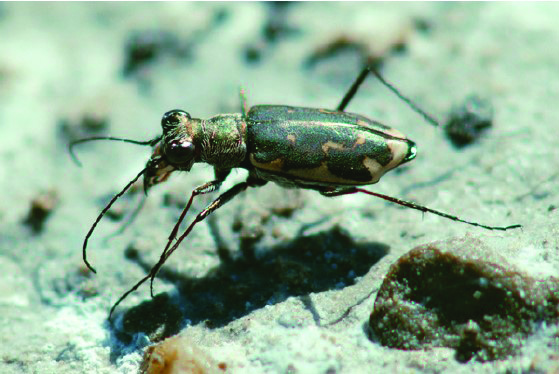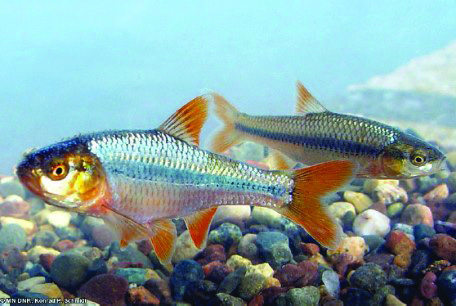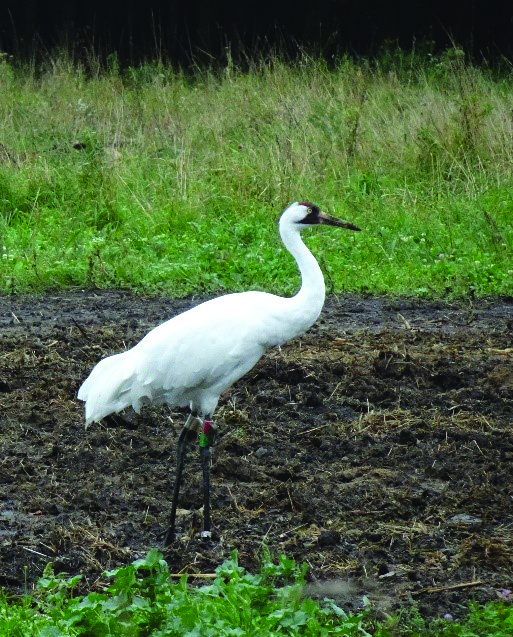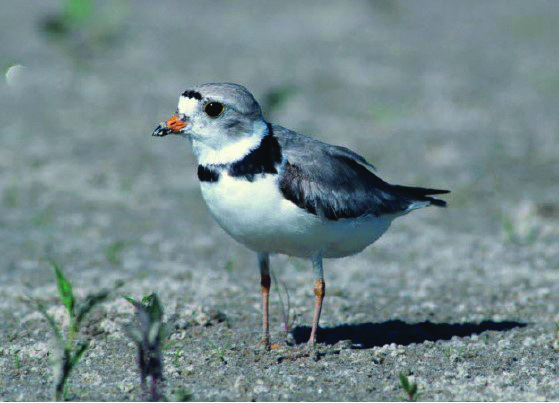

Clyde L. Ogg, Extension Pesticide Safety Educator
Jan R. Hygnstrom, Project Manager
Cheryl A. Alberts, Project Coordinator
Greg J. Puckett, Extension Assistant
This NebGuide discusses the Endangered Species Protection Program and its role in the use of pesticides.
The Endangered Species Act (ESA) is designed to protect animal and plant species in danger of becoming extinct, as well as the ecosystems in which they live. According to the ESA, federal agencies are required to “use their legal authorities to promote the conservation purposes of the ESA and to consult with the U.S. Fish and Wildlife Service and National Marine Fisheries Service, as appropriate, to ensure that effects of actions they authorize, fund, or carry out are not likely to jeopardize the continued existence of listed species” (U.S. Fish & Wildlife Service, 2013). The overall goal of the ESA is to help populations of species recover so they no longer are threatened or endangered. Threatened species have a high probability of becoming endangered in the near future if assistance is not provided. An endangered species is one in danger of becoming extinct in all or most of its range. Each species, whether it is a plant, mammal, fish, or even insect, has a role in the ecosystem. The loss of any species reduces diversity, affecting the well-being of all the other species, including humans.
The U.S. Environmental Protection Agency (EPA) requires and is responsible for registration of pesticides. EPA reviews information and data to determine whether a pesticide product may be registered for a particular use. Because some pesticides may harm certain threatened or endangered species, EPA requires a review of potential impacts. The Endangered Species Protection Program (ESPP) is one of the ways that EPA meets the requirements of the ESA. A primary goal of the ESPP is to manage the use of federally registered pesticides to avoid jeopardizing protected species while also avoiding any unnecessary limitations or restrictions on use. Registered pesticides are important to American agriculture, as well as for maintaining vegetation in transportation and utility rights-of-way, for the control of invasive species, including noxious weeds, and control of vectors (mammals, insects, birds, etc. that may transmit diseases).
A key component of the ESPP is directing pesticide users, through pesticide product labeling, to follow ‘use limitations’ found in Endangered Species Protection Bulletins (ESPB). When referenced on a pesticide label, individuals must refer to the ESPB. All limitations on pesticide use specified in the ESPB are mandatory and enforceable.
ESPBs are accessible through EPA’s Bulletins Live! Two (Figure 1) mapping program at http://bit.ly/34u9Lf2. ESPBs also are available by calling the toll-free Endangered Species Hotline at 1-844-447-3813. Those applying pesticides can check for information in the ESPB as early as six months prior to making a pesticide application.
ESPBs contain (1) the name of the pesticide and active ingredient(s) that may affect listed species; (2) the pesticide use limitation(s) in specific geographic areas that are necessary to protect listed species or designated critical habitat; (3) a map of the user-selected area of interest; and (4) the effective/enforceable date (month and year) of the bulletin.
Figure 1. Bulletins Live! Two on U.S. EPA Website.
A pesticide is included in the ESPP if it poses a potential threat to a federally listed plant or animal species. EPA consults with the U.S. Fish and Wildlife Service to make that determination. This publication covers examples of federal Endangered and Threatened (E&T) animal or plant species that may appear in Endangered Species Protection Bulletins for Nebraska. While all E&T species require special attention, due to space limitations, this publication covers only nine of Nebraska’s species, to explain how pesticides may affect plants, insects, fish, birds, and mammals.
Although ESPP and Bulletins Live! Two apply to federally listed species, applicators must take precautions to protect Nebraska threatened and endangered species as well. For example, the small white lady’s slipper (Cypripedium candidum) is not listed by the federal government as of 2019, but is listed as a threatened species by the state of Nebraska. This plant species is at risk in Nebraska, but apparently doing well in other parts of its range in the US, so is not on the federal list at the time of this printing. The Nebraska Nongame and Endangered Species Conservation Act protects the state’s E&T species. One of the objectives of this Act is to prevent these species from further decline that would cause a listing at the federal level. For a complete listing of state and federal listed species, see http://bit.ly/2M6eD3F. A NE E&T species list by county is at http://bit.ly/35vTCan.
Nebraska range maps, as well as species and habitat descriptions, are available at http://outdoornebraska.gov/endangeredspecies/. Become familiar with state and federally listed species and their habitats in areas where pesticides will be applied, and follow label directions to avoid harming these species and their habitat.
Herbicide applications, drift, and overspray may weaken or kill fragile populations of plants. In addition, pollinators such as bees, butterflies, moths, and flies are important to the survival of many plants. Be careful when applying pesticides that could affect pollinators.
Blowout penstemon (Penstemon haydenii, Figure 2, federal endangered) is unique to the Sandhills region of Nebraska and Carbon County, Wyoming. Blowout penstemon is a “pioneer” plant that begins growth in sand blowouts before most other plant species. In 1968, about 7,000 plants grew on less than 25 total acres scattered throughout the Sandhills. Since then, seeds have been collected and raised in greenhouses, with seedlings introduced to blowouts. About 20,000 plants existed in 2008 due to recovery efforts, primarily in Box Butte, Cherry, Garden, Hooker, and Thomas counties, with populations in Grant and Morrill counties, as well. In 2013, 32 blowout penstemon populations were found in the Sandhills region of Nebraska (10 native sites and 22 introduced populations).
In 2016, the Nebraska Game and Parks Commission (NGPC) surveyed 72 blowouts on 16 sites with known penstemon populations: 37 with re-introduced populations (planted with greenhouse-grown plugs) and 35 with native populations. They found 8,266 plants in the re-introduced populations and 1,930 plants in the native populations. Without active management to maintain open sand, most of the re-introduced and native populations had declined, some substantially, since their last survey.

Figure 2. Blowout Penstemon (Photo Credit: James Stubendieck, UNL).

Figure 3. Western Prairie Fringed Orchid (Photo Credit: NGPC).
Western prairie fringed orchid (Platanthera praeclara, Figure 3, federal threatened) requires a relatively high and constant level of soil moisture, maintained by groundwater that is near the surface. In 2012 NGPC surveyed 65 Sandhills wet meadow and eastern Nebraska tallgrass prairie sites where the orchid was known to exist in previous decades. Surveyors found plants at only 21 (32 percent) of the sites. Of the 21 sites with orchids, their populations had declined, some substantially, at 10 of the sites. Only 596 orchids were found during the survey. Western prairie fringed orchid populations are known to fluctuate from year to year and 2012 was a substantial drought year. The orchid appears to be nearing extirpation (local extinction) in southeastern Nebraska. It relies on the sphinx moth for pollination and seed production, so insecticides and other threats to these insects threaten the orchid as well. Loss of these native pollinators may be impacting pollination and genetic diversity in the western prairie fringed orchid. Other threats include invasive species, annual mid-summer haying, loss of habitat, and herbicide sprays.
Pesticide applications in areas occupied by E&T insects could result in the loss of local populations. Contact with an insecticide, either directly or through particle drift, vapor drift, or runoff, could affect these insects. Herbicide applications can destroy habitat that provides food and shelter for E&T insects.
Salt Creek tiger beetle (Cicindela nevadica lincolniana, Figure 4, federal endangered) is a predatory insect, about ½ inch long, that captures smaller or similar-sized insects by grasping prey with its mouthparts. The beetle spends two years as a larva in an underground burrow, capturing insects that wander by the opening. The adult beetle lives on the surface for only about 6 weeks, from mid-June through July.
Found only in Lancaster and Saunders counties of Nebraska, Salt Creek tiger beetles live in the moist, muddy areas of saline wetlands and stream edges associated with Salt Creek, Little Salt Creek, and Rock Creek. In 2012, researchers counted 374 beetles during an intensive field survey. In 2015, only 174 beetles were counted during the annual survey.
Applications of insecticides in areas occupied by Salt Creek tiger beetles could result in the loss of local populations or the entire subspecies. Both the adult and larvae are susceptible to insecticides. They may be killed through direct contact with insecticides, or they could die from secondary poisoning—eating insects that had been sprayed with an insecticide. Insecticides may reduce the numbers of insects that serve as food for this beetle, as well.

Figure 4. Salt Creek Tiger Beetle (Photo Credit: UNL Department of Entomology Image Library).

Figure 5. American Burying Beetle (Photo Credit: NGPC).
American burying beetle (Nicrophorus americanus, Figure 5, federal endangered) feeds on carrion—dead birds, fish, mammals, and other organisms. It now is found only in six states, including Nebraska. This beetle is the largest North American carrion beetle and may reach up to 2 inches in length. It is nocturnal, seeking out and burying carrion to feed its young.
Availability of carrion and soil moisture, rather than vegetation type, appears to determine the habitat of the American burying beetle. This insect seems to require a soil type that allows for burial of carrion. The species occurs in areas least disturbed by human influence, including the Sandhills and an area southeast of North Platte. Locations include grassland prairie, forest edges, and wet meadows.
Perhaps fewer than 1,000 American burying beetles live east of the Mississippi River. In Nebraska, an estimated 3,000 beetles live in Lincoln County, with the population extending into Gosper, Frontier, and Dawson counties. A northern population of perhaps 30,000 is in the Sandhills of Nebraska, extending into South Dakota. Factors that may play a role in the population decline include habitat fragmentation that lowers the availability of preferred carrion, competition for carrion by other scavengers, and artificial lighting that decreases the populations of nocturnal insects. Contact with insecticides can cause direct mortality or lower reproduction rates. Pesticide applications to control grasshoppers may affect populations of the American burying beetle.
Pesticide applications or runoff could enter streams, ponds, or rivers and harm fish populations. Fish are particularly susceptible to pesticides during their larval development. In addition, most small native fish depend on aquatic insects for survival. Applications of insecticides could affect the fish populations indirectly due to the loss of insects as a food source. Reduce the risk of pesticides entering surface water by establishing adequate buffer strips and using sound agricultural practices to reduce erosion and runoff.
Topeka shiner (Notropis topeka, Figure 6, federal endangered) is a small minnow, less than 3 inches long. Food consists of insects, algae and other plant material, and fish eggs. The Topeka shiner is known to occur in portions of South Dakota, Minnesota, Kansas, Iowa, Missouri, and Nebraska.
It is found in small prairie (or former prairie) streams in pools containing clear, clean water in areas of Cherry County, and the North Loup River. It also is found in Taylor Creek and its tributaries in Madison County. Most streams with Topeka shiner flow year-round, but some are small enough to stop flowing during dry summer months. When this happens, water levels must be maintained by groundwater seepage for the fish to survive. The estimated population in Nebraska is less than 200 fish.

Figure 6. Topeka Shiner (Photo Credit: Konrad Schmidt, Minnesota Department of Natural Resources).
Pesticides in stormwater runoff could enter streams, ponds, or rivers and harm or kill fish and invertebrates such as aquatic insects, crustaceans, and mollusks upon which some shorebirds feed. Fish and invertebrates can accumulate toxins in their bodies; a bird that eats them may have a buildup of toxins as well.
Whooping crane (Grus americana, Figure 7, federal endangered), with a wingspan up to 7.5 feet and standing up to 5 feet tall, is North America’s tallest bird. It has a white body and wings with black wing tips, and a red face and cap. Like Sandhill cranes, they fly with their long necks outstretched and their dark legs straight behind their bodies.
Populations numbered less than 20 around 1950. Thanks to the Endangered Species Act, state programs such as the Nebraska Nongame and Endangered Species Conservation Act, research, and management efforts, bird numbers had grown to 505 by 2017, according to preliminary estimates from the U.S. Fish and Wildlife Service.
Whooping cranes travel through Nebraska in spring and fall, poking the soil for snails, frogs, insects, corn, and wheat. They roost on shallow wetlands and along the Platte River. Their migration takes them from Texas to Alberta and the Northwest Territories, and back again.
Hurdles to increasing the numbers of whooping cranes include habitat loss and illegal shooting. Improper pesticide applications could affect their food supplies.

Figure 7. Whooping Crane (Photo Credit: Jan Hygnstrom, UNL).

Figure 8. Piping Plover (Photo Credit: NGPC).
Piping plover (Charadrius melodus, Figure 8, federal threatened) is a robin-sized shorebird. A common relative, the killdeer, is larger, more darkly colored, and has two dark breast bands.
Piping plovers breed in Nebraska from April through August. Nesting habitat includes extensive, sparsely vegetated areas of sand adjacent to water, including sandbars, sand and gravel beaches, reservoir shorelines, and sand and gravel mines along rivers. Nests are shallow, and are typically lined with small pebbles, shells, or other material. Females lay a clutch of four eggs. Piping plovers feed on small insects, worms, and other invertebrates they collect from the surface of wet sand along the shoreline of rivers, ponds, and lakes. Reduced availability of food due to pollution or other variables can affect survival and reproductive success. The piping plover is found in the Platte, Missouri, Elkhorn, Loup, and Niobrara River drainages. Its decline is attributed to habitat loss, human disturbance at nesting sites, pollution, and disease.
Pesticides may harm mammals if predators or scavengers ingest poisoned animals and carcasses. Pesticides in stormwater runoff could enter streams, ponds, or rivers and harm or kill fish and invertebrates such as aquatic insects, crustaceans, and mollusks upon which some mammals feed. Fish and invertebrates can accumulate toxins in their bodies; a mammal that eats them may have a buildup of toxins as well. In addition, pesticides in streams, ponds, or rivers may degrade water quality.
Black-footed ferret (Mustela nigripes, Figure 9, federal endangered) historically numbered in the tens of thousands in central U.S. prairies; by 1981, just 18 were discovered in Wyoming. Federal breeding and recovery efforts have produced more than 8,000 kits, half of which have been released into their historic prairie territories.
Interestingly, no black-footed ferrets are known to be in Nebraska; however, it is both a state and federal endangered species in the state, because Nebraska was part of its historical range, and because Nebraska has prairie dog towns. Prairie dog towns provide food and shelter for the ferrets, although their holes and competition for grass make them a nuisance to landowners. Prairie dog numbers have declined because of human control, disease, and conversion of prairie to cropland. Their decline has led to declining numbers of black-footed ferrets.
While unlikely that black-footed ferrets will be found in Nebraska, all labels for anticoagulant rodenticides used for prairie dog control have requirements to consult Bulletins Live! Two, and restrictions, which protect ferrets and other non-target birds and mammals that could feed on poisoned carcasses. Rodenticide labels require that a site assessment be conducted to identify active prairie dog burrows. After application, transects must be conducted to look for and dispose of carcasses. Consult Bulletins Live! Two, save the printable bulletin, and follow label instructions. A video on this transect survey is available at http://bit.ly/38Q9RRu.

Figure 9. Black-Footed Ferret (Photo Credit: Public Domain).
When making pesticide applications to, over, or near waters of the state for nonagricultural uses (rights-of-way, mosquito control, algae control, etc.), a National Pollutant Discharge Elimination System (NPDES) permit may be required. In these cases, you must consider if any E&T species, including state-listed species, could be adversely affected. NGPC developed a document with standard procedures, E&T Species Standard Procedures for NPDES Pesticide Permit, available at https://bit.ly/36yWnbr.
If you cannot follow these procedures, you must consult with NGPC prior to the pesticide application. Paperwork must be submitted, and at least 30 days are required for the review. Information on submitting a project for individual review and an informal consultation with NGPC is available in that document. If a review is needed from NGPC, an interactive tool for conservation planning and environmental review, the Conservation and Environmental Review Tool (CERT) is available at https://cert.outdoornebraska.gov . The review can be completed online in 15 minutes.
Endangered and threatened species require special attention due to their vulnerability. Always read pesticide labels carefully. If directed to do so by the label, consult the Endangered Species Protection Bulletins, accessed either online or via telephone. Print and follow the pesticide use limitations given. When applying nonagricultural pesticides to, over, or near waters of the state, a National Pollutant Discharge Elimination System permit may be required. If so, Nebraska Game and Parks Commission has additional standards that must be followed.
Contact the following for additional information.
Nebraska Department of Agriculture (NDA)
Craig Romary, NDA, Lincoln, NE 402.471.2351
NDA List of Threatened and Endangered Species at http://www.nda.nebraska.gov/pesticide/endangered.html
Nebraska Department of Environment and Energy (NDEE)
Alan Aanerud, alan.aanerud@nebraska.gov, Program specialist II, NPDES section, NDEE.
NPDES Pesticides General Permit with Guidance bit.ly/NDEQnpdespest
Nebraska Game and Parks Commission (NGPC)
NGPC, Lincoln, NE 402.471.0641 Threatened and Endangered Species website at http://outdoornebraska.gov/endangeredspecies/.
NGPC Environmental Analyst Supervisor, Michelle Koch, Lincoln, NE 402.471.5438
U.S. Environmental Protection Agency
Mike Daniels, Nebraska Project Officer, Tribal Program Coordinator 913.551.7983
EPA Endangered Species Hotline 844.447.3813
Endangered Species Protection Program at https://www.epa.gov/endangered-species/about-endangered-species-protection-program
Protecting Endangered Species from Pesticides at https://www.epa.gov/endangered-species
U.S. Fish & Wildlife Service (USFWS)
USFWS, Grand Island, NE 308.382.6468
USFWS. 2013. ESA Basics at http://bit.ly/2Etqnce
This publication has been peer reviewed.
Nebraska Extension publications are available online
at http://extensionpubs.unl.edu/.
Extension is a Division of the Institute of Agriculture and Natural Resources at the University of Nebraska–Lincoln cooperating with the Counties and the United States Department of Agriculture.
Nebraska Extension educational programs abide with the nondiscrimination policies of the University of Nebraska–Lincoln and the United States Department of Agriculture.
© 2020, The Board of Regents of the University of Nebraska on behalf of the Nebraska Extension. All rights reserved.